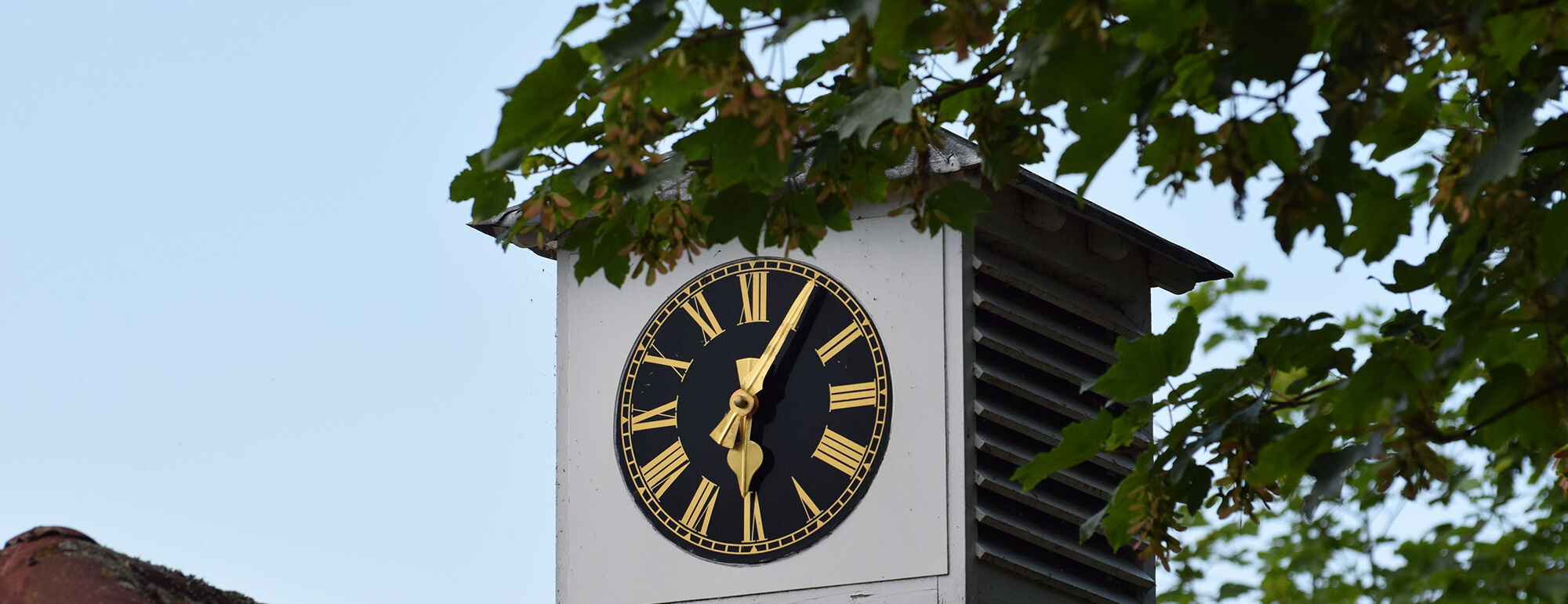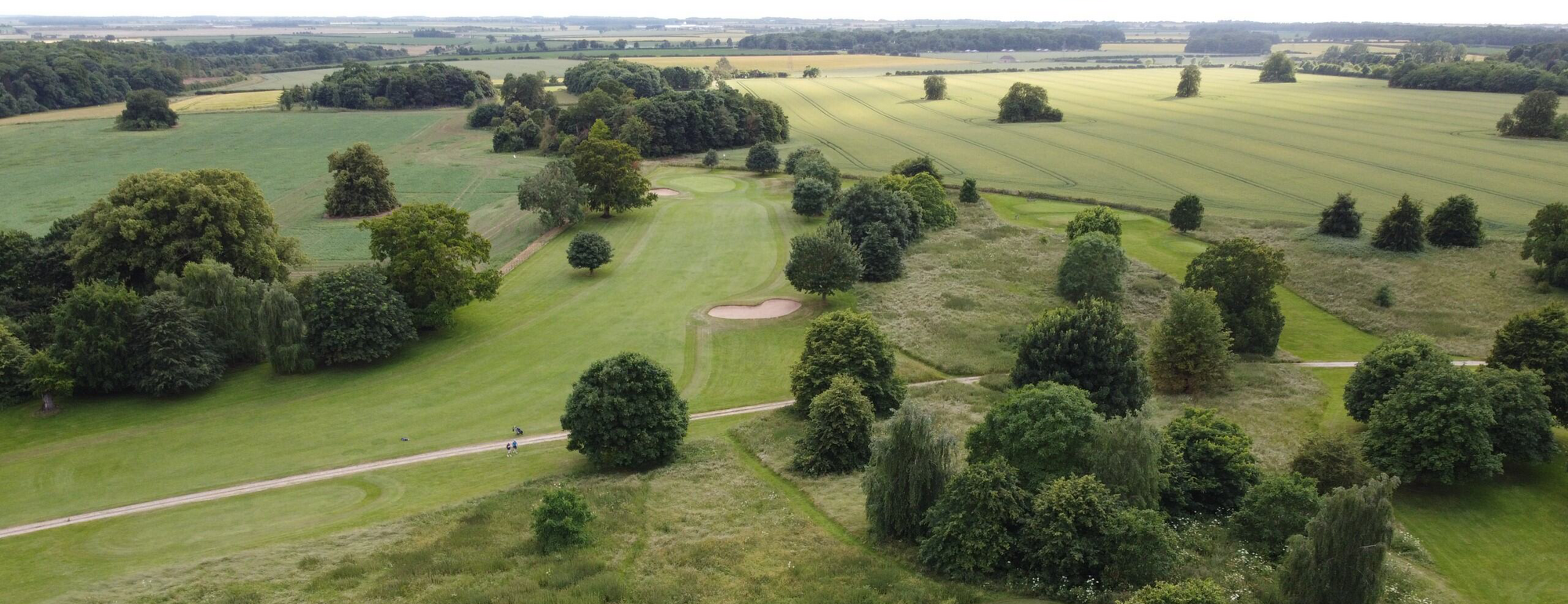History
The Early Days
1719 / 1902
Many centuries old, probably pre-Norman, Blankney is recorded in the Doomsday book as “Blachene” meaning “Blanca’s island of land”. It has changed hands many times, often because of a poor political choice by the occupiers!
In 1719, Thomas Chaplin, a prominent Lincolnshire landowner purchased the land from the Crown Commissioners for Confiscated Land, and it was to remain in the family for over two centuries. The estate owes its appearance largely to the influence of the Chaplins and their care of the land.
The last Chaplin led an extravagant lifestyle and had political ambitions. However this lifestyle coupled to the falling revenues from farms led him ever into debt until finally in 1892, the estate passed to the principal mortgagee Charles Denison, 1st Earl of Londesborough.
In 1902 the Second Earl laid out a nine hole course. In all probability at this stage it was intended for his own personal use and the enjoyment of his guests. In 1904 the club of ‘Blankney Park Golf Club’ was formed having a secretary and captain. Members played the eighteen hole competitions on nine greens, each having two tees. The prizes were a silver spoon for gentlemen valued at 3/6d and the ladies were awarded a silver button worth 1/6d.
These were hardy golfers indeed! Golfers had to share the fairways with the sheep and cattle, and local rules also included the lifting and wiping of balls when they came to rest in animal droppings. The rough yielded an annual crop of hay and, at certain times of the year, the rough was so long that a ball hit into it was usually lost (not so very different from today!). The greens were fenced and the green side bunkers well-located “inside the wire”. This meant that the putting surface was reduced in area and at the front edges of the bunkers were steep. Recovery shots from the bunkers, therefore, a required skill and delicacy. Approach shots from within 25 yards which hit any part of the fencing had to be re-taken.
18 Holes Are Built
1938
Work to extend the course from nine holes at to 18 holes began in 1938, possibly on the initiative of Mr William Parker, the course’s new owner. The work was overseen by Jo Butler, and carried out under the advice and guidance of Colonel Stafford Hochkin, creator of the Woodhall Spa golf course. The extended course was ready for use at the start of the 1940 season. By that time, though, the nation was again at war and many members had departed to answer the calls of military service.
Throughout the Second World War, the club’s financial difficulties remained desperate, exacerbated by a fall in the number of members, by reduced green fee income, by petrol rationing, and by wartime wage inflation. Twice, special meetings were called to discuss whether or not the club could continue. On each occasion, the decision “to carry on” was taken. The meetings also considered, but rejected, at the idea of reverting to a nine-hole course. It was argued that investments made in the new holes would be lost if the holes were not brought into use. It was felt, also, that 18 holes would be essential if the club’s membership was to recover after the war.
The course, therefore, remained open as an 18-hole course throughout the war years and provided, no doubt, a welcome recreational facility for the many RAF personnel stationed in the area. Three things, in particular, helped to save the club from wartime extinction: first, a number of members agreed to pay three years’ annual subscription in advance; second, the landlords agreed not to press for payment of rents until hostilities had ceased; finally, a number of RAF stations in the area had made “block membership” arrangements with the club, and the income from these arrangements provided a welcome addition to the coffers.
In the immediate post-war years, the financial position of the club remained precarious. It’s income continued to be low and there was little money to spare for investment and course improvements. The club came to depend heavily on the efforts of a small number of dedicated volunteers for the completion of routine maintenance tasks. Equipment and labour were borrowed from local farmers and builders and, on one occasion, the club negotiated the temporary use of a County Council steamroller for the flattening of greens!
Despite the appointment of a club professional, membership numbers continue to be disappointingly low. Each year new admissions were just about cancelled out by resignations and there was always a small annual outflow of members choosing to join other Lincolnshire clubs. It had become fairly obvious that the presence of livestock on the course requiring the fencing of the greens served to inhibit membership growth.
The situation began to change in the mid-1960s when the landlords decided to move the cattle to other pastures. The sheep followed in the late 1970s. Initially, all livestock was moved from the area of parkland north of the dividing hedge, which separated the first two holes from the rest of the course. Some years later, livestock was also moved from the area south of the hedge. By 1983, the entire course was livestock-free and the greens were fence-free. There was an immediate upsurge in the course’s popularity, and the annual outflow of the members was reversed.
The Course is Redesigned
1936
In 1986, the club committee engaged the services of Cameron Sinclair a golf architect. He was asked initially to redesign the opening four holes and to create a par 5 finishing hole. The landlords had made more land available and this lead to the construction of four new greens and two new fairways, the siting of new bunkers, and the creation of an ornamental lake in front of the new second green. These improvements were completed by 1988. They were paid for in the main by proceeds from the sale of some 40 “life memberships”.
The course improvements yielded quick results. There was an almost immediate rise in membership applications and a corresponding reduction in annual departures to other clubs. For the first time there was a waiting list for membership and there was also a big increase in green fee income.
The committee, well pleased with Cameron Sinclair’s early work, then asked him to produce a development plan for the rest of the course. This plan was to achieve three main objectives: first, to increase the course par to 72 by an increase in lengthening the 8th hole to a par-five; second, to remove the internal “out-of-bounds” alongside the 14th fairway and, third; to align the par-three holes so that each one played in a different direction in relation to the prevailing wind. The development plan was accepted by the committee and, more importantly, by the landlords, who were keen to see improvements made. The plan was to be implemented gradually.
Only four of the original 18 greens were to survive Cameron’s attentions: the old Second (now the first); the old Third (now the 5th); the old Fifth (now the 7th); and the old 10th (now the 12th). The remaining greens were either in the wrong place or deemed by Cameron to be below the required standard. When the new greens were constructed, and a major consideration was to minimise the need for watering by the creation of putting areas resistant to the encroachment of shallow-rooted meadow grass. Some of the new greens were seeded from scratch; others were laid with imported turf; others were laid with turf recovered from the park. These differences in construction strategy may perhaps account for the variations in pace, which used to plague the course.
Cameron Sinclair’s work, however, was not universally applauded. Some members complained that the development plan caused a number of well-liked features to be discarded, such as the dog-leg on the 14th fairway and the “double green” shared by the old 9th and 14th holes. This double green provided a huge target for an approach shot, but sometimes necessitated 40 yard putts. Other members felt that Cameron’s elevated greens, with their undulating putting surfaces, were more in keeping with Scottish links than with English parkland.
The committee of the day needed all their tact and powers of persuasion when a number of members raised a formal objection to the proposed relocation of the 13th hole-a short, downhill, par-three with tight bunkers on either side of a small hourglass green. The golfer whose tee-shot on this hole found one of the bunkers was fortunate to escape with the score better than a “double-bogey”. The “aerial” route to the green was so fraught with risk that some of the less able golfers resorted, with occasional success, to using a putter or a “jigger” from the tee. Although computer records showed it to be the most punishing hole on the course, it was, nevertheless, pleasing to the eye, and popular with the members. The objectors were finally mollified when it was pointed out to them that the 13th green was dangerously in line with the newly sited 12th tee.
A Private Members Club Becomes Proprietary, then back to Private Members
In the begining Blankney Golf Club had been a “members club” run by an unpaid, part-time committee which was responsible for aspects of the club’s affairs. So long as the annual rent was paid and there was no conflict with the interests of Blankney Estates, the landlords took no direct part in the club’s management. This arrangement worked well enough when the club had a relatively small number of members, however, this depended on the success, hard work and dedication of the officers and committee members who, over the years, had given their time, and sometimes money, unstintingly, to ensure the club’s well-being.
As the membership grew, the day-to-day problems of running the club became more complex. For example, with larger entries to competitions, sometimes requiring the use of 2 starting points, and with the increased demand for access to the course at weekends, the accuracy of the start-time booking sheet assumed critical importance. Another example was in the maintenance of membership and handicap records. The rather antiquated use of a card-index “spinner” used hitherto for this purpose proved to be an unsatisfactory device when membership numbers increased. There was no master list of names, addresses and telephone numbers, and there was no invoicing system for the collection of annual subscriptions. Reliance was simply placed on “SUBSCRIPTIONS ARE NOW DUE” notice. It was sometimes late May before subs were gathered in.
It had become apparent that a more professional approach to club management was required. The appointment in 1988 of Ian Macintosh as a salaried part-time secretary (20 hours a week) and the acquisition of a computer in place of the “spinner” alleviated the difficulties but did not remove them. Furthermore, the financial soundness of the club was always in doubt. Towards the end of each financial year, the club frequently had to rely on bank overdrafts to tide itself over until the next batch of annual subscriptions came in. A further complication arose in the early 1990s from a change in the agricultural rating system, which, overnight, added hugely to the club’s financial obligations.
In 1991, the Board of Blankney Estates made an offer to take over the club’s financial assets and liabilities and to assume responsibility for the day-to-day management of the club, leaving the club committee to deal only with the organisation of golfing activities and social events. After lengthy discussion of details between the board and committee, the offer was put to a postal ballot of all members. The outcome of the ballot was an overwhelming vote in favour of acceptance. As a consequence Blankney Golf Club became a “proprietary club”.
Since the change to a proprietary club status there has been a large injection of resources into the club and club house. Implementation of the development plan has accelerated. By the end of 1997, most of the plan improvements and alterations had been completed. Subsequent alterations included the installation of an improved irrigation system, the enhancement of water storage facilities, the creation of pathways for trolleys, and the construction of a new halfway house. Steve Peters, the old course manager, has engineered a number of extra modifications to the original plan and has set in train a programme for future improvements. This work was continued and developed by course manager John Hart and is now being enhanced by new course manager Richard Parsons who was appointed in June 2024.
In June 2024 Blankney Golf club once again became a Private members Club run by the Board of Blankney Golf Club Limited (BGCL). BGCL was set up by the members to take the club to the next stage of its development, with an aim to be the best parkland golf course in Lincolnshire. This will take time as mother nature cannot be rushed, but the significant investment in the course will enable this to happen.
History of the Clubhouse
In the early days, there was no clubhouse as such, just a “club room “. This clubroom , the location of which is not known with certainty, was used for meetings and for the serving of teas. At a committee meeting on 15th June 1909, the price of playing tees were set at 6d, and teas “with German cakes” at 8d.
On 20th May 1911 the committee instructed the secretary to negotiate with the landlord for the renting of “three rooms and an indoor lavatory for the exclusive use of the Golf Club”. Captain Spooner, Lord Londesborough’s agent, wrote back to say that the former Inn was available. Tenancy was offered “at yearly rent of £4, now or half-yearly, and a three months’ notice on either side to terminate, the landlord to pay all rates and taxes”. The committee speedily accepted the offer. The rooms in “Tally Ho!” which were not required by the club were sub-let to “Duke” Reynolds, the green keeper, at a rent of £3 a year.
In 1938, because of the landlords need to reallocate the tenancy of the “Tally-Ho!”, the clubhouse was moved to a cottage, once supposedly the village “Reading Room”, on the opposite side of the main road next to the cricket field gate. Electricity was installed and a new caretaker, Mrs Edith Riley, was engaged at a wage of five shillings a week to clean, light fires at weekends and collect green fees. She was allowed to serve teas for her own profit. Behind this cottage was a wooden hut which had been given to the villagers by Lord Londesborough for the use as the village social club. The hut housed a full-sized snooker table, also the gift of Lord Londesborough. To begin with, though, the golf club’s accommodation and the social club’s accommodation were kept strictly separate.
In June 1945, the club had, for the first time applied for and obtained a licence to sell alcoholic drinks on the club premises. In the following year, the Golf Club and the village social club were formally amalgamated. The clubhouse came in effect, the “Village Pub”. All residents of the village became social members of the Golf Club and the golf club members had the use of the facilities of this social club, notably, the snooker table. A number of the village residents, having taken up golf, transferred to playing membership.
Five years after the amalgamation, the clubhouse was moved again, this time to its present location, a stone cottage named “Travers Lodge” just a few doors down the road from the “Tally Ho!”. The building is said to have been so named because an ATS officer named A.T. Travers was billeted there during the Second World War. Thanks to the efforts of Joe Butler and the estate force, the wooden hut, along with the snooker table, was moved at the same time to a place alongside the cottage. The two buildings were connected by a covered walkway. An “L-shape” extension was later added to the hut to allow space for a lounge area. The “L-shape” has been preserved in the layout of the present clubhouse.
As opposed to a new club house, major alterations were decided upon. The professional’s shop was to be relocated; the dining room was to be enlarged and the kitchen modernised; new Ladies’ and Gentlemen’s locker rooms were to be built, and a wooden hut housing the snooker table was to be replaced by a stone building on the same site.
The whole club house was to be refurbished and refitted to a high standard. The improvements and alterations were originally to be paid for by the members themselves from a special club house-improvement fund, which had been set aside. However, following the change of status to a proprietary club, responsibility for making the alterations was accepted by the landlords who paid all the building and fitting costs, including the hire of a Portakabin to serve as a temporary bar whilst the alterations were carried out. The club house improvement fund was used to purchase internal furnishings. The alterations were finally completed in 1992, when the new club house was officially opened by the Club President.
From time to time, some members have expressed regret that Blankney does not have a club house “on the course”, as do many other clubs, a “19th hole” from which members can observe playing progress. Against this is the argument that Blankney club house, located where it is, better reflects the club’s history and character, in particular the club’s close ties with the estate and the village. The new clubhouse is modern in its fittings and elegantly furnished, but has retained its essential cottage “feel”, and it blends in perfectly with its surroundings.











